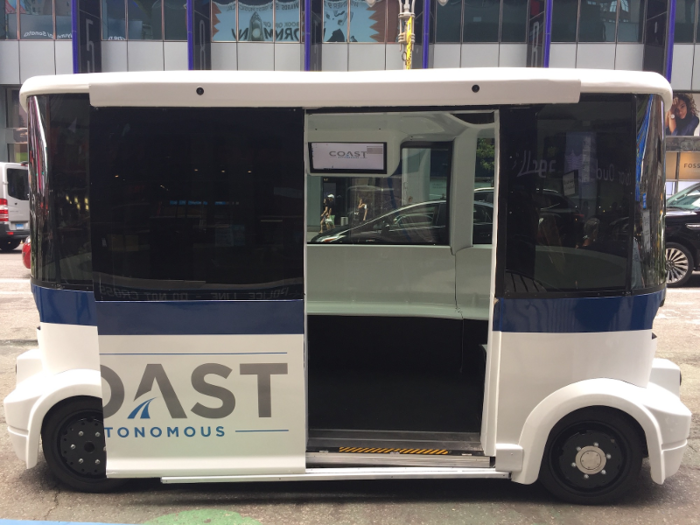
It has a maximum speed of 25 mph, a maximum 10 hours of range (it drops to five hours if air-conditioning is turned on), and the ability to charge wirelessly.

It can seat 14 passengers on its semi-circular bench and has room for six additional passengers if they stand. Passengers can see the shuttle's route and estimated time of arrival at upcoming stops on a screen above them.

When demand is high, the vehicle can travel on a set route. But during periods of low demand, passengers can have the shuttle pick them up and drop them off at their chosen destination.
Pierre Lefevre, Coast's CTO, said it has developed a fleet management system to make sure the shuttle isn't stopping too frequently. For example, if multiple people who are close to each other hail the shuttle, it will find a place to stop between them.
Lefevre said in dense urban environments, like New York City, passengers will board the Coast P-1 at predetermined stops and choose which stop they want to exit at on an iPad inside the vehicle.

Whether the vehicle will have to turn or move in only two directions will depend on the environment in which it makes its full-scale debut. Lefevre said the company would prefer to operate the shuttle near a body of water.
"Seaside or lakeside would be better for us," he said.

The shuttle went back and forth along a small, closed-off area separated from other vehicles. It didn't turn, interact with traffic, or model how it might respond to users who hail it with an app. Lefevre had to prompt the shuttle to move in one direction with an Xbox controller.
The vehicle has two lidar units — which shoot out pulses of light to detect objects and determine how far away they are — on each end. It uses artificial intelligence software to make decisions about how to operate and robotic software to stop, start, and steer, according to Coast's website.

Full autonomy could be at least five to 10 years away for consumer vehicles. The first examples of completely autonomous driving will come in vehicles operating in limited environments, like the ride-hailing services Waymo and Cruise plan to launch this year and next, respectively.
It remains to be seen how Coast's technology will fare in a major city, but by using conservative, low-speed vehicles and limiting where they can travel, the company has decreased the number of challenges its technology has to address.
 A centenarian who starts her day with gentle exercise and loves walks shares 5 longevity tips, including staying single
A centenarian who starts her day with gentle exercise and loves walks shares 5 longevity tips, including staying single  A couple accidentally shipped their cat in an Amazon return package. It arrived safely 6 days later, hundreds of miles away.
A couple accidentally shipped their cat in an Amazon return package. It arrived safely 6 days later, hundreds of miles away. FSSAI in process of collecting pan-India samples of Nestle's Cerelac baby cereals: CEO
FSSAI in process of collecting pan-India samples of Nestle's Cerelac baby cereals: CEO 7 Nutritious and flavourful tiffin ideas to pack for school
7 Nutritious and flavourful tiffin ideas to pack for school
 India's e-commerce market set to skyrocket as the country's digital economy surges to USD 1 Trillion by 2030
India's e-commerce market set to skyrocket as the country's digital economy surges to USD 1 Trillion by 2030
 Top 5 places to visit near Rishikesh
Top 5 places to visit near Rishikesh

Copyright © 2024. Times Internet Limited. All rights reserved.For reprint rights. Times Syndication Service.